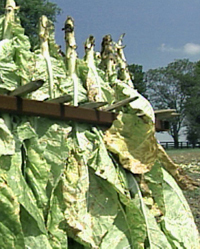Weather and Disease Problems Spell Losses for Kentucky's Burley Crop
Weather and Disease Problems Spell Losses for Kentucky's Burley Crop

Early wet weather combined with later drought and disease problems mean losses in both quantity and quality for this year’s burley tobacco crop.
“The outlook for this year’s crop is not good,” said Gary Palmer, Extension tobacco specialist in the University of Kentucky College of Agriculture. “There are a few bright spots mainly in the southern tier of the state, but even in the southern part some producers have not fared well due to drought.”
Although the USDA’s September crop report estimated Kentucky’s burley crop at just less than 203 million pounds, or 90 percent of effective quota, that figure likely will drop in the October report.
“I think beltwide marketings could fall 20 percent or more short of the quota,” said Will Snell, UK Extension agricultural economist. “On the favorable side, the pool recently sold about 50 million pounds of stocks due to tobacco companies expecting a lower quantity and quality this year. Of course, that not only helps keep our no-net cost fee assessment down, but will also have a tendency to help our quota situation for 2003.”
Kentucky’s 2002 crop got off to a questionable start with excessive spring rains. Wet weather affects the tobacco plant’s ability to develop its root system, meaning later weather conditions can have a bigger impact.
“I always say the wetter you start the more moisture you’re going to need later on because the plant just doesn’t have the root system established that it needs to support itself during dry conditions,” said Palmer.
In addition to drought, producers also had to contend with disease problems and curing setbacks.
“This was the worst year anyone can remember for black shank,” said Palmer. “And then hot, dry, windy weather contributed to a very quick cure that set a lot of color and chemistry into the crop that’s considered undesirable at the market.”
According to his own estimates, Palmer believes this year’s crop could be down by as much as 30 million pounds below the state average.
Quality variation likely will lead to price variability and perhaps lower prices for the 2002 crop.
“However, demand for the smaller crop is expected to remain strong despite quality concerns, resulting in a limited volume going under loan,” said Snell. “Domestic purchase intentions, along with exports may remain relatively stable for 2003 quota calculations, and thus lower pool stocks could lead to a modest increase in the 2003 basic quota.”